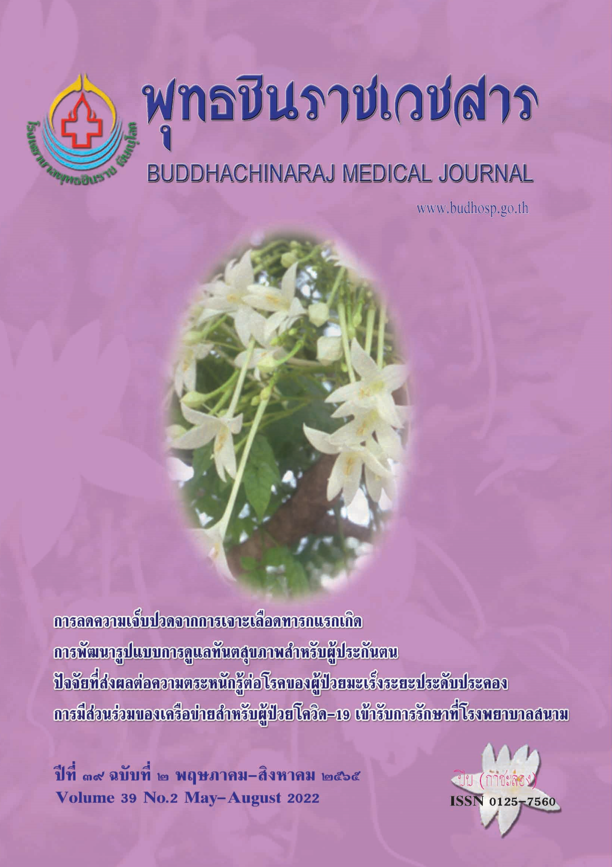การเปลี่ยนแปลงค่าซีรัมครีเอตินินหลังได้รับยาโคลิสติน
การเปลี่ยนแปลงค่าซีรัมครีเอตินินหลังได้รับยาโคลิสติน
คำสำคัญ:
การเปลี่ยนแปลงค่าซีรัมครีเอตินิน, รูปแบบการบริหารยาโคลิสติน,ภาวะไตเสียหายเฉียบพลันบทคัดย่อ
แบคทีเรียแกรมลบดื้อยาหลายขนานเป็นปัญหาสำคัญของการติดเชื้อในโรงพยาบาล ส่งผลให้ใช้ยาโคลิสตินมากขึ้น ซึ่งรูปแบบการบริหารยามี ทั้งทางหลอดเลือดดำอย่างเดียว, หลอดเลือดดำร่วมกับพ่นละอองฝอย และพ่นละอองฝอยอย่างเดียว แต่ยังไม่มีแบบแผนการติดตามค่าซีรัมครี เอตินินที่ชัดเจนทำให้ผู้ป่วยบางรายมีผลการรักษาไม่ดีเท่าที่ควรงาน วิจัยเชิงวิเคราะห์ครั้งนี้มีวัตถุประสงค์เพื่อวิเคราะห์รูปแบบการบริหารยา colistin 3 รูปแบบข้างต้นต่อการเกิด AKI รวมทั้งปัจจัยที่เกี่ยวข้องกับ การเกิด AKI โดยศึกษาข้อมูลย้อนหลังจากเวชระเบียนผู้ป่วยในอายุ ตั้งแต่15 ปีขึ้นไปที่ใช้ยาโคลิสตินรักษาในโรงพยาบาลศรีสังวรสุโขทัย ระหว่างวันที่ 1 มกราคม พ.ศ. 2561 ถึง 30 มิถุนายน พ.ศ. 2562 ที่ได้ บันทึกค่าซีรัมครีเอตินินทุกครั้ง ติดตาม 20 วัน นำเสนอเป็นค่าความถี่ ค่าร้อยละ ค่าเฉลี่ย และค่าเบี่ยงเบนมาตรฐานเปรียบเทียบข้อมูลส่วน บุคคล/ทางคลินิกระหว่างผู้ที่เกิด/ไม่เกิด AKI ด้วย chi-square test, Mann-Whitney U test และ independent t-test วิเคราะห์ปัจจัยที่ เกี่ยวข้องกับการเกิด AKI ด้วย univariate logistic regression และ multiple logistic regression กำหนดระดับนัยสำคัญทางสถิติที่ 0.05 พบว่ากลุ่มผู้สูงอายุ, เพศชาย, การบริหารยาทางหลอดเลือดดำอย่างเดียวและทางหลอดเลือดดำร่วมกับพ่นละอองฝอย, ระยะเวลาการ ให้ยานานเป็นปัจจัยเสี่ยงของการเกิด AKI อย่างมีนัยสำคัญทางสถิติซึ่ง สามารถใช้เป็นข้อมูลประกอบการจัดทำแนวทางการสั่งใช้ยา colistin ตลอดจนเฝ้าระวังและติดตามการเกิด AKI
เอกสารอ้างอิง
Noopetch P, Suanrabbit C. Gram-negative resistance: mechanisms and clinical implement. In: Wanichanan C, Paitoonpong L, editors. Combat the resistance. Bangkok, Thailand: Print & More; 2018. p.141-370.
Mendes RE, Mendoza M, Banga Sigh KK, Castanheira M, Bell JM, Turnidge JD, et al. Regional resistance surveillance program results for 12 Asia-Pacific nations (2011).Antimicrob Agents Chemother 2013;57(11):5721-6.
Rice LB. Mechanisms of resistance and clinical relevance of resistance to β-lactams, glycopeptides, and fluoroquinolones. Mayo Clin Proc 2012;87(2):198-208.
Rattanaamphawan P. Promoting and directing the proper use of antimicrobial drugs in hospital. In: Rattanaamphawan P, editor. Treatment of antimicrobial resistant gram-negative bacterial infections. Bangkok, Thailand: Siriraj Publishing House; 2018. p.143-72.
Thamlikitkul W. Colistin: an antimicrobial drug for the treatment of gram-negative infections. Siriraj Med Bull 2008;1(3):152-7. [cited 2018 Apr 5]. Available from: https://he02.tci-thaijo.org/index.php/simedbull/article/view/82129/65276
Sitaruno S, Sintimaleworakul W. Efficacy and safety of the practical use of colistin. Thai J Pharm Pract 2018;10(2):505-16.
Kritmethapak K. Acute kidney injury. In: Kritmethapak K, editor. Handbook of clinical nephrology. Khon Kaen, Thailand:Department of Internal Medicine, Khon Kaen University: 2019. p.1-126.
Colistimetate Sodium. In: In depth answers [database on the internet]. 2018 [cited 2018 Apr 5]. Available from: www.micromedex solutions.com
Kumanachai P. Principles of pharmacokinetics and pharmacokinetics in antimicrobial dosage adjustments. In: Rattanaamphawan P, editor. Treatment of antimicrobial resistant gram-negative bacterial infections. Bangkok, Thailand: Siriraj Publishing House; 2018. p.111- 21.
Nation RL, Garonzik SM, Thamlikitkul V, Giamarellos-Bourboulis EJ, Forrest A, Paterson DL, et al. Dosing guidance for intravenous colistin in critically-ill patients. Clin Infect Dis 2017;64(5):565-71.
Rattanaumpawan P, Lorsutthitham J, Ungprasert P, Angkasekwinai N, Thamlikitkul V. Randomized controlled trial of nebulized colistimethate sodium as adjunctive therapy of ventilator-associated pneumonia caused by gram-negative bacteria. J Antimicrob Chemother 2010;65(12):2645-9.
Kim YK, Lee JH, Lee HK, Chung BC, Yu SJ, Lee HY, et al. Efficacy of nebulized colistin-based therapy without concurrent intravenous colistin for ventilator-associated pneumonia caused by carbapenem-resistant Acinetobacter baumannii. J Thorac Dis 2017; 9(3):555-67.
Hamer DH. Treatment of nosocomial pneumonia and tracheobronchitis caused by multidrug-resistant Pseudomonas aeruginosa with aerosolized colistin. Am J Respir Crit Care Med 2000;162(1):328-30.
Athanassa ZE, Myrianthefs PM, Boutzouka EG, Tsakris A, Baltopoulos GJ. Monotherapy with inhaled colistin for the treatment of patients with ventilator-associated tracheobronchitis due to polymyxin-only-susceptible gram-negative bacteria. J Hosp Infect 2011;78(4):335-6.
Areewattanon W. Factors associated with acute kidney Injury in patients taking colistin at Nongkhai Hospital. Sakon Nakhon Hospital Med J 2021;24(3):46-56.
ดาวน์โหลด
เผยแพร่แล้ว
ฉบับ
ประเภทบทความ
สัญญาอนุญาต
ลิขสิทธิ์ (c) 2022 พุทธชินราชเวชสาร

อนุญาตภายใต้เงื่อนไข Creative Commons Attribution-NonCommercial-NoDerivatives 4.0 International License.






